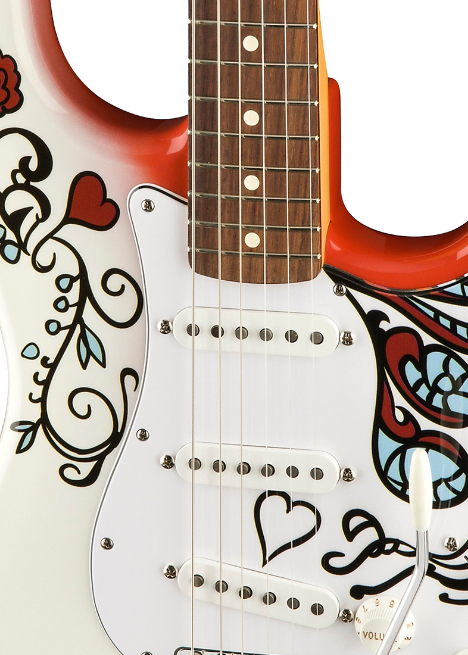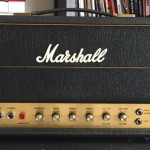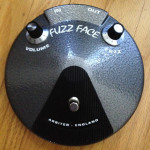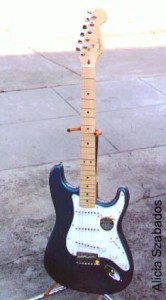 Jimi Hendrix reaches the end of an already incendiary set at the 1967 Monterey International Pop Festival, when he takes off his black Stratocaster, and straps on another Strat. This formerly red Strat now features a hand-painted white base and personal designs applied with nail polish by the young guitarist earlier in the day. As he plugs in, strumming it to get in tune, he laughs and makes a seemingly offhand remark to the euphoric crowd about sacrificing “something I love,” before summoning a wall of feedback to start the set-closing “Wild Thing.” Unknown to everyone but Jimi, the Strat is now an offering to the audience and his destiny, the guitar a legendary piece, and then pieces, of modern history.
Jimi Hendrix reaches the end of an already incendiary set at the 1967 Monterey International Pop Festival, when he takes off his black Stratocaster, and straps on another Strat. This formerly red Strat now features a hand-painted white base and personal designs applied with nail polish by the young guitarist earlier in the day. As he plugs in, strumming it to get in tune, he laughs and makes a seemingly offhand remark to the euphoric crowd about sacrificing “something I love,” before summoning a wall of feedback to start the set-closing “Wild Thing.” Unknown to everyone but Jimi, the Strat is now an offering to the audience and his destiny, the guitar a legendary piece, and then pieces, of modern history.
Continue reading
Tag Archives: stratocaster
Fender’s Mod Shop Expands for Summer and Fall 2017: Enables Direct Online Creation of Custom Instruments
 In between a Fender production instrument that one can purchase from a dealer and a Fender custom shop instrument, is the Fender Mod Shop. The Mod Shop opened its doors in June of 2016 and is Fender’s online digital design studio where users can directly create and customize their instrument from a variety of options otherwise not available on standard off-the-shelf models.
In between a Fender production instrument that one can purchase from a dealer and a Fender custom shop instrument, is the Fender Mod Shop. The Mod Shop opened its doors in June of 2016 and is Fender’s online digital design studio where users can directly create and customize their instrument from a variety of options otherwise not available on standard off-the-shelf models.
Fender recently expanded its palette of offerings for the Summer and Fall of 2017, with some options being offered for only a limited time. From new body and pickguard colors, neck shapes, and pickups, the online Mod Shop offers a variety of options to create an instrument that is truly unique.
Continue reading
Finding Your Distortion Tone (Hint: Mids)
 If only things were so easy that we could buy the guitar we felt comfortable with, plug into an amp, maybe add a pedal or two, and then be done. Tone Nirvana. It usually doesn’t happen this way however. The problem is that there are numerous choices for gear and, and even more options for putting together the whole rig, to create an effective system that is optimized. And just how we use the equipment (whether for live use or studio recording) also makes a difference in finding what works for guitarists.
If only things were so easy that we could buy the guitar we felt comfortable with, plug into an amp, maybe add a pedal or two, and then be done. Tone Nirvana. It usually doesn’t happen this way however. The problem is that there are numerous choices for gear and, and even more options for putting together the whole rig, to create an effective system that is optimized. And just how we use the equipment (whether for live use or studio recording) also makes a difference in finding what works for guitarists.
We recently wrote about the challenges with the Internet and its opinions. You can find as many people who will love or hate any particular piece of gear. This can become frustrating when trying to dial in a tone you’re interested in capturing.
Continue reading
Sonus Pedals Fuzz Face 1966 Replica Reviewed
It has been some time since we wrote our Fuzz Feast series about both vintage and  recent fuzz options on the market. After seeing the prices of original fuzz units climb, I wondered what the boutique market now had available in 2015 as far as the most accurate of Fuzz Face clones. During my search, I stumbled across Sonus Pedals based in the Netherlands and its Fuzz Face 1966 replica.
recent fuzz options on the market. After seeing the prices of original fuzz units climb, I wondered what the boutique market now had available in 2015 as far as the most accurate of Fuzz Face clones. During my search, I stumbled across Sonus Pedals based in the Netherlands and its Fuzz Face 1966 replica.
Continue reading
Vintage Style Pickups Explored: Part 1 – Single Coil Stratocaster Replacements
With so many different types of pickups on the market, choosing one that’s just right for you can certainly be a challenge. For typical non-active pickups used in most guitars today, the materials used and how each pickup is constructed can make a large difference in the final tone achieved. Active pickups (i.e., those that have some form of pre-amplification built in that requires the use of a battery of some type) are a whole different category altogether.
For the sake of focus, this two-part series will discuss varieties of vintage style pickups. First, we’ll take a look at some single-coil options that you’d typically use in a Stratocaster. Next time, we’ll bring out the Les Paul and play with some vintage-voiced humbuckers. As we go through the various options, some vendors were kind enough to provide great educational info about how each pickup is made and why they’ll sound a particular way. This will be helpful for the person that may not necessarily be interested in a vintage-voiced pickup but can use the information to read over the specifications of another pickup and then perhaps get a better understanding of how each specification may affect the tone.
Continue reading
The Fender Custom Shop Experience
Jimi Hendrix. David Gilmour. I grew up admiring both of these artists…and their Stratocasters. Hendrix is most famously known for his late ’60s white “Woodstock” Strat, while Gilmour is best known for his black Strat (now a signature Fender model) which is a “mutt” of various parts – but started out as a circa 1968 stock model.
These late ’60s Strats are most easily identified by use of the large headstock design that originated after the CBS purchase of Fender musical instruments in 1965. Hendrix can be seen with his favorite Strat (he preferred his black one over the white he used at Woodstock) in his famous performance captured on video at The Isle of Wight in 1970. Gilmour used an identical black with maple board model in the Pink Floyd “Live at Pomeii” film shot in 1972. These classic performances, and those Stratocasters, left an impression on me that continues to this day.
Continue reading
2000 Fender American Standard Strat
 Year 2000 marks the end of the American Standard Stratocaster line and the introduction of Fender’s new American Series Stratocaster. Many marked refinements were incorporated in the new American Series Stratocasters that we’ll examine in the future. However, because the American Standard Stratocaster has been discontinued, it means that there are potentially great deals to be found in the marketplace. For that reason, as well as to mark the end of the American Standard Stratocaster’s 13-year life, LegendaryTones.com decided to examine some of the history of the American Standard Stratocaster as well as look at the year 2000 model in depth.
Year 2000 marks the end of the American Standard Stratocaster line and the introduction of Fender’s new American Series Stratocaster. Many marked refinements were incorporated in the new American Series Stratocasters that we’ll examine in the future. However, because the American Standard Stratocaster has been discontinued, it means that there are potentially great deals to be found in the marketplace. For that reason, as well as to mark the end of the American Standard Stratocaster’s 13-year life, LegendaryTones.com decided to examine some of the history of the American Standard Stratocaster as well as look at the year 2000 model in depth.
The first of Fender’s famous and long-lived American Standard Stratocasters was introduced in 1987 at the NAMM Convention and was a hit from the start. Fender was now in its post-CBS era, and the company’s new management team was committed to bringing Fender back to its glory days by again producing high-quality affordable instruments. In the 70’s especially, the CBS-owned Fender company suffered from a reputation for producing poorly-made guitars as a result of mass production and poor quality control. Being owned by mega-giant CBS did nothing but encourage the notion that the company only cared about profits. However, with new owners and the new American Standard model introduced, Fender clearly succeeded in time and the company again enjoyed a renewed reputation for producing quality instruments.
Continue reading